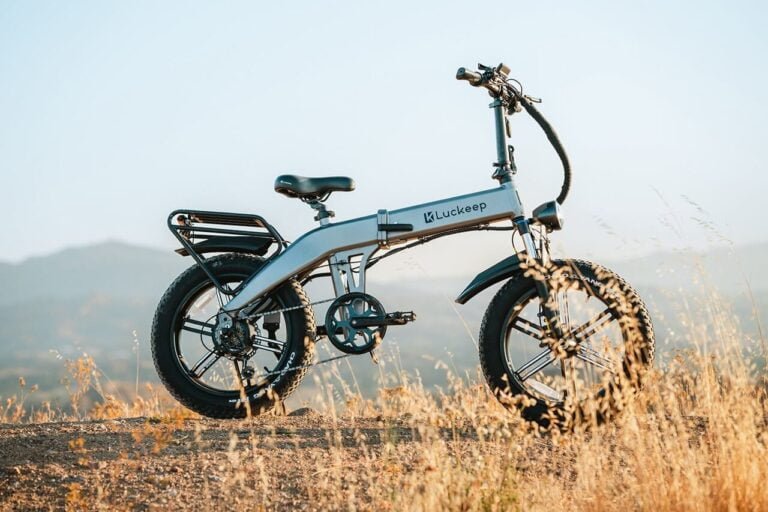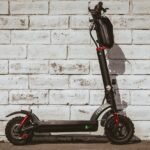

Qlife Cityone 2.0 Electric Bike — Easy, Fast & UL-Certified Commuter
Our take: a low-step city e-bike with punchy 1200W peak power, a UL2849-certified 48V battery, and assist up to 28 mph—great value for everyday rides.
- Low-step frame, upright posture, ergonomic seat — effortless on/off and all-day comfort
- 48V 499Wh (UL2849) removable battery; IPX5 weather-ready; up to 65 miles in optimal conditions
- Peak 1200W brushless hub + 7-speed drivetrain; assist up to 28 mph for quicker commutes
- Front suspension, 26×2.1" tires & dual disc brakes — smooth, stable, and confident stopping
- Motor
- Peak 1200W hub
- Battery
- 48V 499Wh (UL2849)
- Top Speed
- Up to 28 mph
- Range
- Up to 65 miles
If you’re shopping for a no-drama commuter e-bike that’s easy to live with, the Qlife Cityone 2.0 hits a sweet spot that a lot of riders care about: approachable step-through frame, real-world speed up to 28 mph, a 48V 499 Wh UL-certified battery, and a peak output listed at 1,200 W for punchy get-up-and-go. On paper it promises a 65-mile max range, and in practice it aims to be the kind of everyday ride that lets you forget about traffic, hills, and headwinds.
At first glance the Cityone 2.0 looks like a classic city bike that went to the gym—clean lines with the battery tucked inside the down tube, a front suspension fork to take the edge off rough pavement, and 26-inch wheels wrapped in 2.1-inch tires for a confident but nimble feel. It’s available in multiple colors (Black, Grey, White, Yellow, Purple, Red, Green), and the low-step frame makes mounting and dismounting effortless whether you’re in jeans, office wear, or riding with a child seat on the back.
Underneath the friendly silhouette is a practical spec sheet: 7-speed Shimano drivetrain, dual mechanical disc brakes, a bright front light, and an ergonomic saddle built for longer spins. The bike arrives with the tools you need to assemble it, and its UL2849 certification is a meaningful safety box checked for riders who care about standards. This is a budget-friendly commuter with enough speed to hang with traffic when you need to—minus the complexity or price premium of more exotic builds.
Is Qlife Cityone 2.0 for you?
The Cityone 2.0 is designed to solve a very common problem: making daily transportation simpler, faster, and more enjoyable. If your use case is commuting to work or school, grocery runs, fitness rides around town, or weekend coffee hops, this platform fits right in. The upright posture, step-through design, and adjustable cockpit reduce the intimidation factor for newer riders and keep long rides comfortable for experienced ones.
This bike is for riders who want easy access and easy speed without chasing complicated settings or high maintenance. It’s beginner-friendly and wonderfully forgiving—hop on, select your assist level, and go. The 28 mph top speed (throttle/assist) provides enough headroom to shorten commutes, and the 48 V system gives the motor the voltage it needs to feel lively on hills.
It’s not the perfect match if you’re hunting for a lightweight carbon chassis, a mid-drive motor for mountain trails, or hydraulic brakes for repeated steep descents. The steel frame and city-spec 2.1-inch tires prioritize stability and durability over featherweight performance, and the fork is for comfort rather than aggressive off-road riding.
Budget-wise, Cityone 2.0 sits in the value/entry segment. That said, the feature mix—UL2849 battery, up-to-28 mph speed class, and integrated battery design—makes it feel a rung higher than the price would suggest.
What We Like About Qlife Cityone 2.0
What stands out immediately is approachability. The step-through frame means no gymnastics at traffic lights and no awkward mounts when carrying groceries or wearing a backpack. Paired with the ergonomic saddle and upright geometry, it encourages daily use; you don’t need to dress like a cyclist to ride it.
The power system is well-chosen for an urban bike. A 48 V pack provides strong voltage for efficient power delivery, and the claimed 1,200 W peak from the brushless hub motor translates into brisk starts and confident hill handling. Hitting up to 28 mph in assist makes a tangible difference on longer commutes, and the seven-speed drivetrain gives you enough gearing to pedal comfortably across a broader speed range.
We also appreciate the UL2849 certification. Battery safety is top of mind for many buyers, and having a system tested to that standard is reassuring. The built-in battery adds weather resistance (rated IPX5) and theft deterrence compared to some external systems, yet it remains removable for convenient charging.
Ride comfort is strong for the category: the front suspension fork and 2.1-inch tires provide a supple ride on city streets, potholes, and the occasional gravel path. The dual disc brakes (mechanical) offer predictable, easy-to-service stopping power, and the integrated lighting improves dusk and night visibility. Add in multiple colorways and adjustable handlebar/seat posts, and you have a commuter that accommodates a wide range of riders from about 5’3″ to 6’3″ with a listed max load of 350 lb.
What We Don’t Like About Qlife Cityone 2.0
The mechanical discs do the job, but riders in hilly regions or those carrying heavy loads may wish for hydraulics, which offer lighter lever feel and stronger bite with less hand effort—especially in wet conditions. The fork is designed for comfort; it’s not a performance suspension unit, so don’t expect mountain-bike levels of small-bump sensitivity or adjustability.
With a carbon-steel frame, durability is high, but weight is generally more than an aluminum chassis. If you live in a walk-up or you’re routinely lifting the bike onto a rack, bear this in mind. The 2.1-inch tires ride nicely on pavement yet aren’t the best match for sand, snow, or loose trail—this isn’t a fat-tire adventure bike.
Finally, the marketing claim of up to 65 miles is realistic only under conservative conditions (lower assist, lighter rider, flatter terrain, and steady pacing). Urban reality—stop-and-go riding, hills, wind, frequent throttle use—will shorten that. That’s normal for the class, but worth setting expectations.
Pros & Cons
| Pros | Cons |
|---|---|
| Friendly low-step frame for easy on/off | Mechanical (not hydraulic) disc brakes |
| 48 V 499 Wh UL2849 battery, removable & built-in (IPX5) | Steel frame adds weight compared with aluminum |
| Peak 1,200 W hub motor feels lively in traffic | 2.1″ tires are pavement-biased; not for deep sand/snow |
| Up to 28 mph assist for faster commutes | Range claim (up to 65 miles) assumes gentle PAS use |
| Front suspension smooths rough streets | Fork is comfort-oriented; not a performance unit |
| Ergonomic seat, upright posture; adjustable cockpit | |
| Dual disc brakes for dependable stopping | |
| Multi-color options and clean, integrated battery design |
What’s Included?
- Electric bike ×1
- Tools kit ×1
- Key ×1
- Charger ×1
- User manual ×1
- Front headlight ×1
Package impressions: everything required to assemble and ride is in the box, and the inclusion of a headlight is welcome for safety. We’d always love to see full-coverage fenders and a bell in the carton for all-weather commuting; if they’re not included in your package, they’re useful, inexpensive add-ons. Otherwise, this is a comprehensive starter kit that new riders can build on as needs evolve.
Technical Specifications
| Item | Spec |
|---|---|
| Frame | Low-step, carbon-steel city frame |
| Wheel size | 26″ |
| Tires | 26″ × 2.1″ city tires |
| Suspension | Front fork shock absorption |
| Drivetrain | 7-speed (Shimano) |
| Motor | Brushless hub, peak 1,200 W |
| Battery | 48 V 499 Wh, removable, UL2849 certified |
| Claimed range | Up to 65 miles (conditions dependent) |
| Claimed top speed | Up to 28 mph |
| Brakes | Dual mechanical disc |
| Waterproof rating | IPX5 (battery/bike weather resistance) |
| Lighting | Front LED headlight |
| Rider height | Suggested 5’3″–6’3″ |
| Max load | 350 lb |
| Selected geometry | Total length 68.3″, handlebar height 44.6″, wheelbase 35.3″, standover 30.1″ (per manufacturer visuals) |
Geometry is provided for fit guidance; expect small variances between production runs.
Features
- UL2849-Certified 48V 499 Wh Battery – Safety-tested system housed inside the frame; removable for charging; weather-resistant to IPX5.
- Peak 1,200 W Brushless Hub Motor – Confident launches, headwind punching power, and assist up to 28 mph.
- Low-Step Frame – Easy mounting/dismounting for riders of varied heights; friendly for city stop-and-go.
- Front Suspension Fork – Smooths broken pavement and light gravel; comfort-first tuning.
- 2.1-inch City Tires (26″) – Balanced blend of stability and agility with better rolling efficiency than fat tires.
- Dual Mechanical Disc Brakes – Reliable, easy to service, and adequate for commuting duty.
- 7-Speed Drivetrain – Lets you pedal comfortably at neighborhood pace or at 20–28 mph assist speeds.
- Integrated Headlight – Improves conspicuity when riding at dawn/dusk or in poor weather.
- Adjustable Cockpit & Ergonomic Seat – Upright posture with pressure relief, reducing fatigue on longer rides.
- Multiple Colorways – A commuter that doesn’t force you into basic black.
Feature impressions: For a value-tier commuter, this is a richly equipped package. The integrated battery cleans up the frame lines and reduces exposure to the elements. The drivetrain/motor pairing gives new riders confidence in hillier neighborhoods and keeps cadence natural at higher speeds. Mechanical discs are practical and proven; they’re also the easiest to tune for first-time owners. The 2.1-inch tire width is the right call if your riding is 90% pavement—efficient, quiet, and secure. Overall, the spec choices show a focus on everyday usability rather than hobbyist tinkering, which is exactly what many commuters want.
Real-World Riding Notes
Acceleration & hill performance. With a 48 V system and a peak claim of 1,200 W, the Cityone 2.0 pops off the line quickly in higher assist levels. It’s not a wheel-spinner, but in urban traffic it feels eager and reduces the effort required to get up to cruising pace. On inclines, the motor keeps a steady pull that makes climbs feel manageable; shift the 7-speed drivetrain appropriately and you’ll avoid lugging the motor.
Speed & stability. Up to 28 mph assist is meaningful. You’ll spend most of your time between 15 and 23 mph in mixed traffic, but having that extra headroom for open sections or to match the flow of cars makes commuting safer. The 26-inch wheels and moderate tire width deliver a reassuring, neutral feel—quick enough to thread through bike lanes yet planted enough to let one hand signal without wobble.
Comfort & fit. The low-step frame transforms quick errands into true “grab-and-go.” The adjustable seatpost and handlebar height help dial in posture for different torso/arm lengths, and the ergonomic saddle with a wider rear section reduces hot spots on longer rides. The fork is tuned to take the sting out of potholes and expansion joints; you’ll still feel the road, but the sharp edges are muted.
Braking. Dual mechanical discs supply dependable braking power. Lever feel is progressive, and maintenance (cable stretch adjustments and pad swaps) is straightforward. In very wet conditions or with heavy cargo, you’ll squeeze a bit harder than with hydraulics, but the system is predictable and confidence-inspiring once you’ve bedded the pads.
Range reality. The “up to 65 miles” figure is achievable with lighter riders on flat routes using low PAS and steady cadence. If you rely on throttle, ride hilly terrain, or hold higher assist levels, expect practical ranges in the 25–45-mile window—still perfectly adequate for most daily commutes with on-site charging at work or home.
Noise & refinement. The hub motor whirrs politely without harsh resonance. Internal battery placement reduces cable clutter and rattles, and the steel frame’s inherent damping makes the bike feel solid rather than buzzy.
Sizing & Practicality
Qlife suggests a rider height range of 5’3″ to 6’3″ with a 350 lb max load. The long seat tube and adjustable cockpit help share the bike across household members, and the step-through design is accommodating for riders with limited mobility. The 26-inch wheel format is a smart middle ground for city riding: easier roll-over than 24″ while keeping the standover and step-through low.
Daily practicality is enhanced by the integrated battery—less to snag on racks, fewer exposed wires, and better weather sealing. The IPX5 water-resistance rating means the bike is fine to ride in rain; as always, avoid submersion and wipe down moving parts after wet rides to extend component life. Add fenders and a rear cargo solution if your commute includes wet roads or groceries.
Maintenance & Ownership
One of the perks of a hub-motor commuter is low maintenance. Mechanical discs, a 7-speed drivetrain, and a straightforward electrical system make upkeep simple:
- Keep the chain clean and lubed; check brake pads/cables monthly.
- Top off tire pressure weekly for rolling efficiency and puncture resistance.
- Use the included key to remove the battery for room-temperature charging; never charge in extreme heat/cold.
- Because the system is UL2849 certified, you’re starting from a stronger safety baseline—still, store and charge in a ventilated area away from flammables as good practice.
Parts availability (tires, tubes, brake pads, cables) is standard and easy to source. If you later decide to upgrade to hydraulic brakes or a suspension seatpost, the platform lends itself to those common add-ons.
Comparisons & Context
Within the value commuter class, the Cityone 2.0 distinguishes itself by pairing a low-step frame with up to 28 mph assist and a UL-certified battery—three features that don’t always show up together at this tier.
Some rivals offer larger-capacity batteries but cap assist at 20 mph; others match the 28 mph speed but use external battery bricks or lack certification.
If you demand hydraulic brakes out of the box, you’ll typically step up a price tier; for many riders, the mechanical setup here is perfectly adequate and easier to live with.
Who Should Buy This?
- New e-bike riders who want a confidence-boosting, low-step design with enough power not to outgrow it in six months.
- Daily commuters seeking a weather-resistant, UL-certified battery system and a comfortable ride posture.
- Fitness-minded city riders who prefer pavement efficiency over the bulk of fat-tire bikes.
- Households sharing one e-bike thanks to broad fit adjustability and approachable handling.
Skip it if your plan is off-road trail riding, hauling very heavy cargo on steep grades (where a mid-drive and hydraulics shine), or if frequent lifting/carrying up stairs is part of your routine and weight is a top priority.
Tips for Best Results
- Dial in tire pressure to the middle of the sidewall range for a sweet spot between comfort and speed; lower a bit for wet days.
- Start in lower PAS when launching on slick surfaces; bring assist up as you roll.
- Brake bedding: perform a few controlled stops from ~15 mph to seat pads and rotors for quieter, stronger braking.
- Range planning: for longer days, ride PAS 2–3 and keep cadence smooth; save higher levels for headwinds and hills.
- Security: the integrated battery and included key help, but add a reputable U-lock/cable combo and register your serial number.
Final Breakdown
| Preview | Product | Price | |
|---|---|---|---|
|
|
Qlife Cityone 2.0 Electric Bike for Adults,Up to 65Miles,28MPH,1200W Peak Motor 26″ Ebike,499WH… | $499.99 | Add to Cart on Amazon |
9.0 / 10
The Qlife Cityone 2.0 nails the fundamentals of a modern city e-bike: easy access, enough speed to matter, dependable stopping, and a UL-certified 48 V battery integrated into a clean, weather-resistant frame. It’s built for riders who want to ride more and fuss less, and it succeeds by focusing on pragmatic choices—front suspension for comfort, 2.1-inch tires for efficient city roll, and a drivetrain/motor pairing that makes hills and headwinds feel smaller.
Sure, mechanical discs and a steel frame won’t thrill spec hunters, and the 65-mile headline range is best-case. But those trade-offs are sensible at this price class, and they keep the bike accessible and easy to maintain. If your goal is a reliable, comfortable daily ride that looks good, feels secure, and gets you where you’re going faster—with fewer car keys in your life—the Cityone 2.0 is an excellent pick.



![10 Best Foldable Electric Bikes for Adults in [year]: Power, Range & Comfort 10 Best Foldable Electric Bikes for Adults: Power, Range & Comfort](https://goebikelife.com/wp-content/uploads/2025/10/Best-Foldable-Electric-Bikes-for-Adults-768x512.jpg)
![Top Heybike Electric Bike Reviews ([year]): Which Model Is Right for You? Heybike Electric Bike Reviews](https://goebikelife.com/wp-content/uploads/2024/09/Heybike-Electric-Bike-Reviews-768x512.jpg)



